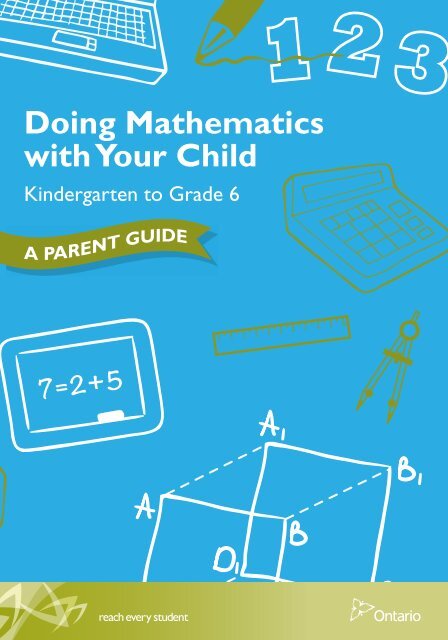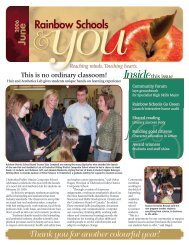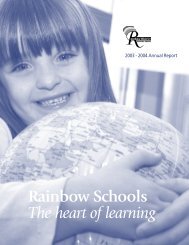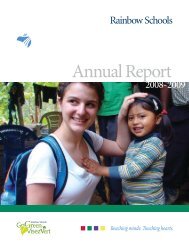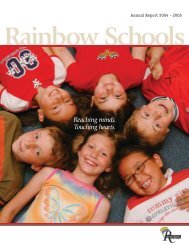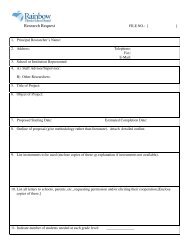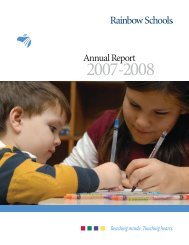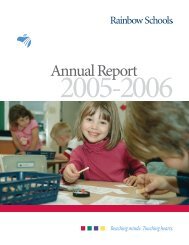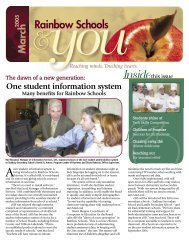Doing Mathematics with Your Child, Kindergarten to ... - EduGains
Doing Mathematics with Your Child, Kindergarten to ... - EduGains
Doing Mathematics with Your Child, Kindergarten to ... - EduGains
Create successful ePaper yourself
Turn your PDF publications into a flip-book with our unique Google optimized e-Paper software.
<strong>Doing</strong> <strong>Mathematics</strong><br />
<strong>with</strong> <strong>Your</strong> <strong>Child</strong><br />
<strong>Kindergarten</strong> <strong>to</strong> Grade 6<br />
7 = 2 + 5
Contents<br />
7 = 2 + 5<br />
Note <strong>to</strong> Parents ..............................................................................................................................................2<br />
How can I support my child’s learning? .........................................................................................2<br />
Why is a belief in our children’s ability <strong>to</strong> learn mathematics essential? ...............................3<br />
What are the connections <strong>to</strong> the curriculum? .............................................................................4<br />
<strong>Doing</strong> <strong>Mathematics</strong> <strong>with</strong> <strong>Your</strong> <strong>Child</strong>, <strong>Kindergarten</strong> <strong>to</strong> Grade 6<br />
is an update of the ontario Ministry of education’s Helping <strong>Your</strong><br />
<strong>Child</strong> Do <strong>Mathematics</strong>: A Guide for Parents.<br />
Produced by the literacy and Numeracy secretariat in<br />
partnership <strong>with</strong> the Parent engagement office. New <strong>to</strong> this<br />
edition: links <strong>to</strong> online games and activities on tvokids.com.<br />
some Fun Family learning experiences ............................................................................................5<br />
Numbers are everywhere! ...............................................................................................................5<br />
How high? How low? How much? How little? ..........................................................................15<br />
What’s your angle on that? .............................................................................................................20<br />
Over and over again! ........................................................................................................................24<br />
What are the chances? ....................................................................................................................29<br />
online resources ........................................................................................................................................36<br />
tvokids.com and Math ...........................................................................................................................37<br />
The greater the support that families provide for their<br />
children’s learning and educational progress, the more likely<br />
that their children will do well in school and continue on<br />
<strong>with</strong> their education.<br />
Karen Mapp and anne henderson, 2002<br />
A New Wave of Evidence:<br />
The Impact of School, Family, and Community<br />
Connections on Student Achievement<br />
<strong>Doing</strong> <strong>Mathematics</strong> <strong>with</strong> <strong>Your</strong> <strong>Child</strong>, <strong>Kindergarten</strong> <strong>to</strong> Grade 6: A Parent Guide<br />
1
Note <strong>to</strong> Parents<br />
Note <strong>to</strong> Parents<br />
How can I support my child’s learning?<br />
You are an important partner in your child’s mathematics education.<br />
When you find ways <strong>to</strong> engage your child in thinking and talking about mathematics,<br />
you are providing an important key for unlocking his or her future success.<br />
Today, critical thinking, problem solving, reasoning ability and the ability <strong>to</strong> communicate<br />
mathematically are essential skills. These processes are the foundation of mathematics<br />
instruction in Ontario schools. They are brought in<strong>to</strong> play as you engage your child in the<br />
activities suggested in this guide.<br />
Enjoy learning <strong>to</strong>gether!<br />
Top Tips for Parents<br />
Why is a belief in our children’s ability <strong>to</strong> learn mathematics essential?<br />
Understanding mathematics builds confidence and opens doors <strong>to</strong> many jobs and<br />
careers. Understanding mathematics enables us <strong>to</strong>:<br />
• Solve problems and make sound decisions<br />
• Explain how we solved a problem and why we made a particular decision<br />
• Use technology (such as calcula<strong>to</strong>rs and computer applications) <strong>to</strong> help<br />
solve problems<br />
• Understand patterns and trends so that we can make predictions (for example,<br />
we can keep track of how much juice is consumed so that we know how much juice <strong>to</strong><br />
buy each week)<br />
• Manage our time and money (for example, we can calculate how much time we need<br />
<strong>to</strong> get <strong>to</strong> work, how much food we need <strong>to</strong> make meals and how much money we<br />
need <strong>to</strong> buy food)<br />
• Handle everyday situations that involve numbers (such as figuring out when the next<br />
bus will arrive and dividing a recipe)<br />
• Build strong, positive attitudes about math. When children feel positively<br />
engaged and successful, they are more likely <strong>to</strong> stick <strong>with</strong> an activity or a<br />
problem <strong>to</strong> find a solution.<br />
• Begin <strong>with</strong> activities that meet your child’s level of mathematical<br />
understanding. Early success in solving problems will build your child’s<br />
confidence. Gradually move <strong>to</strong> activities that provide more challenge for<br />
your child.<br />
• If you and your child are more comfortable in a language other than<br />
English, use it. <strong>Your</strong> child will understand concepts better in the language that<br />
he or she knows best.<br />
Before your child can learn mathematics, he or she needs <strong>to</strong> believe in his or her ability<br />
<strong>to</strong> do so. That’s where you come in. You can be your child’s first role model for learning.<br />
When you engage <strong>with</strong> your child in a supportive, relaxed atmosphere, your child will<br />
enjoy taking risks while having fun <strong>with</strong> math!<br />
7 = 2 + 5<br />
Please note: In this guide, the word parent refers <strong>to</strong> parents, guardians,<br />
caregivers and other family members who help children learn mathematics.<br />
2 3<br />
<strong>Doing</strong> <strong>Mathematics</strong> <strong>with</strong> <strong>Your</strong> <strong>Child</strong>, <strong>Kindergarten</strong> <strong>to</strong> Grade 6: A Parent Guide<br />
<strong>Doing</strong> <strong>Mathematics</strong> <strong>with</strong> <strong>Your</strong> <strong>Child</strong>, <strong>Kindergarten</strong> <strong>to</strong> Grade 6: A Parent Guide
Note <strong>to</strong> Parents<br />
What are the connections <strong>to</strong> the curriculum?<br />
The activities in this guide were selected <strong>to</strong> help your child see math in everyday activities.<br />
They also build on children’s love of games. And they support the learning expectations in<br />
the Ontario mathematics curriculum.<br />
Remember that you don’t have <strong>to</strong> do all the activities in this guide <strong>to</strong> support your child’s<br />
math success. And although many activities have been included, they don’t cover everything<br />
in the curriculum. The guide offers a sampling of the kinds of activities that you can do <strong>with</strong><br />
your child <strong>to</strong> encourage him or her <strong>to</strong> start thinking – and talking – mathematically!<br />
You will recognize the names of the five strands of the Ontario mathematics curriculum<br />
from reading your child’s report card.<br />
The Five Strands<br />
Numbers are everywhere!<br />
You will find activities that support Number Sense and Numeration on the<br />
orange pages. This is the strand in the Ontario mathematics curriculum that is<br />
about understanding how numbers work and how they relate <strong>to</strong> each other.<br />
It also covers the basic operations: addition, subtraction, multiplication and division.<br />
Number Sense and Numeration provides the foundation for mathematical thought.<br />
Legend<br />
Numbers are everywhere!<br />
How high? How low? How much? How little?<br />
What’s your angle on that?<br />
<strong>Kindergarten</strong> <strong>to</strong> Grade 3<br />
Number Sense and Numeration<br />
Measurement<br />
Patterning and Algebra<br />
Data Management and Probability<br />
Over and over again!<br />
What are the chances?<br />
Geometry and Spatial Sense<br />
Learning <strong>to</strong> Think (and Talk) Like a Mathematician<br />
The Ontario mathematics curriculum emphasizes seven processes that are<br />
essential for learning mathematics:<br />
• Problem solving<br />
• Reasoning and proving<br />
• Reflecting<br />
• Connecting<br />
• Selecting <strong>to</strong>ols and<br />
computational strategies<br />
• Representing<br />
• Communicating<br />
In each grade, a set of “mathematical process expectations” describes how children<br />
actively learn and apply mathematical understanding.<br />
Ontario <strong>Mathematics</strong> curriculum:<br />
www.edu.gov.on.ca/eng/curriculum/elementary/math18curr.pdf<br />
4<br />
<strong>Doing</strong> <strong>Mathematics</strong> <strong>with</strong> <strong>Your</strong> <strong>Child</strong>, <strong>Kindergarten</strong> <strong>to</strong> Grade 6: A Parent Guide<br />
<strong>Doing</strong> <strong>Mathematics</strong> <strong>with</strong> <strong>Your</strong> <strong>Child</strong>, <strong>Kindergarten</strong> <strong>to</strong> Grade 6: A Parent Guide<br />
5
Numbers are everywhere!<br />
So Many Things <strong>to</strong> Count!<br />
Benefits<br />
When children first begin <strong>to</strong> count, they learn important mathematical ideas:<br />
• One-<strong>to</strong>-one correspondence (one number for one object)<br />
• Stable order (we count 1, 2, 3, 4, … not 1, 2, 7, 5, …)<br />
• Cardinality (the last number counted tells how many)<br />
Tip!<br />
When children are learning <strong>to</strong> count, they like <strong>to</strong> <strong>to</strong>uch, point <strong>to</strong> and<br />
move objects as they say the number aloud – so encourage them <strong>to</strong>!<br />
• Have your child count <strong>to</strong>ys, kitchen utensils, items of clothing as they come out of the<br />
dryer, collections (such as stickers, but<strong>to</strong>ns or rocks) and any other items your child<br />
shows interest in counting.<br />
• Mix it up! Have your child count a set of objects but start at different places in the set<br />
(for example, start counting in the middle of the set rather than at the beginning).<br />
This helps <strong>to</strong> develop the idea that the counting of objects can begin <strong>with</strong> any object in<br />
a set and the <strong>to</strong>tal will still be the same.<br />
• Sing counting songs and use counting in meaningful ways in games, such as<br />
Hide-and-Seek. Counting games, rhymes and songs exist in every culture.<br />
Some counting songs and rhymes help children <strong>to</strong> count forward and backward<br />
as well.<br />
• Have your child skip count (counting by twos, fives or tens) <strong>to</strong> count larger groups of<br />
items quickly. Use such objects as blocks, pasta pieces, <strong>to</strong>othpicks or but<strong>to</strong>ns.<br />
Number Sense and Numeration<br />
How Many?<br />
Benefits<br />
As children count, they learn <strong>to</strong> connect quantities (such as five but<strong>to</strong>ns)<br />
<strong>with</strong> their number names (such as the word five) and symbols (such as 5).<br />
• Develop your child’s awareness of the symbols used <strong>to</strong> represent numbers by<br />
making it a game. Look for number symbols in your home and neighbourhood: on<br />
the television remote, on the microwave, on the telephone keypad, in flyers and<br />
media, on signs and on team sweaters.<br />
• Play a number version of I Spy. For example, “I spy something that has the number<br />
five on it,” or “I spy something in this room that there are three of.”<br />
• Ask for your child’s help <strong>to</strong> count items in your home. “I wonder how many chairs<br />
we have around the table? In this room? In the house?” Count windows, light<br />
switches, lamps or beds. You might record “how many” by using a combination of<br />
numbers and pictures.<br />
<strong>Kindergarten</strong> <strong>to</strong> Grade 3<br />
6 <strong>Doing</strong> <strong>Mathematics</strong> <strong>with</strong> <strong>Your</strong> <strong>Child</strong>, <strong>Kindergarten</strong> <strong>to</strong> Grade 6: A Parent Guide<br />
<strong>Doing</strong> <strong>Mathematics</strong> <strong>with</strong> <strong>Your</strong> <strong>Child</strong>, <strong>Kindergarten</strong> <strong>to</strong> Grade 6: A Parent Guide<br />
7
Numbers are everywhere!<br />
Solve Everyday Problems<br />
Number Sense and Numeration<br />
Adding and Subtracting Made Fun<br />
<strong>Kindergarten</strong> <strong>to</strong> Grade 3<br />
Tip!<br />
Encourage your child <strong>to</strong> talk about and show a math problem in a<br />
way that makes sense <strong>to</strong> her or him – for example, your child may act<br />
it out, use the actual materials, draw it or count on his or her fingers!<br />
Benefits<br />
By playing these games, your child will learn there is no right way <strong>to</strong> add and<br />
subtract – mathematicians use a variety of strategies.<br />
Involve your child in using numbers <strong>to</strong> solve problems and make everyday decisions.<br />
You might ask the following:<br />
• “We need six <strong>to</strong>ma<strong>to</strong>es <strong>to</strong> make our sauce for dinner, and we have only two.<br />
How many more do we need <strong>to</strong> buy?”<br />
• “You have two pillows in your room and your sister has two pillows in her room.<br />
How many pillowcases do I need <strong>to</strong> wash?”<br />
Tip!<br />
Encourage your child <strong>to</strong> use a strategy that makes sense <strong>to</strong> him or<br />
her – for example, a “counting-on” strategy might help your child<br />
keep track of the score in a game, starting <strong>with</strong> the larger number<br />
(such as 12) and then counting on the remaining quantity (such as<br />
13, 14, 15, …).<br />
• “Two guests are coming <strong>to</strong> eat dinner <strong>with</strong> us. How many plates will we need?<br />
How many utensils?”<br />
More challenging situations might involve adding or subtracting larger numbers,<br />
or situations in which your child has <strong>to</strong> add or subtract more than once <strong>to</strong> solve<br />
the problem.<br />
1 Red Apple<br />
1 Pillow<br />
1 Plate<br />
You can make up games that involve adding and subtracting numbers by using<br />
number cubes and number cards. Have your child help you make four or more sets<br />
of number cards. Each card will have a number from one <strong>to</strong> ten on one side of it.<br />
Here are some games <strong>to</strong> try:<br />
• Higher Number. Shuffle or mix up the cards and then leave them face down in a<br />
pile. Each player takes two cards and adds the numbers. The player <strong>with</strong> the higher<br />
sum gets the other player’s cards. Players continue <strong>to</strong> take and add up two cards<br />
at a time until no cards are left. The player <strong>with</strong> more cards is the winner. You<br />
can play the same game <strong>with</strong> subtraction, but it would be called Lower Number.<br />
The player <strong>with</strong> the lower difference (answer) gives his or her cards <strong>to</strong> the other<br />
player. The person <strong>with</strong> the fewest cards at the end is the winner. You can play the<br />
same game <strong>with</strong> multiplication.<br />
• Number Cube Twice. Each player rolls two number cubes and adds the numbers<br />
shown. The higher number wins. You can play the same game <strong>with</strong> subtraction and<br />
multiplication.<br />
• Ask for your child’s help <strong>to</strong> count items in your home. “I wonder how many chairs<br />
we have around the table? In this room? In the house?” Count windows, light<br />
switches, lamps or beds. You might record “how many” by using a combination of<br />
numbers and pictures.<br />
8<br />
<strong>Doing</strong> <strong>Mathematics</strong> <strong>with</strong> <strong>Your</strong> <strong>Child</strong>, <strong>Kindergarten</strong> <strong>to</strong> Grade 6: A Parent Guide<br />
<strong>Doing</strong> <strong>Mathematics</strong> <strong>with</strong> <strong>Your</strong> <strong>Child</strong>, <strong>Kindergarten</strong> <strong>to</strong> Grade 6: A Parent Guide<br />
9
Numbers are everywhere!<br />
The Broken Calcula<strong>to</strong>r Game<br />
Number Sense and Numeration<br />
One Half Equals One Half – Or Does It?<br />
<strong>Kindergarten</strong> <strong>to</strong> Grade 3<br />
Benefits<br />
Benefits<br />
Mathematicians know that there are different ways <strong>to</strong> represent a quantity –<br />
for example, 18 can be represented as 20 – 2 and as 15 + 3.<br />
A fraction shows the relationship between a part and the whole.<br />
When comparing two fractions, your child will learn <strong>to</strong> consider what<br />
the size of the “whole” is.<br />
• Ask your child <strong>to</strong> pretend that the number 8 key on the calcula<strong>to</strong>r is broken.<br />
Ask how he or she can make the number 18 appear on the screen <strong>with</strong>out the<br />
8 key. (Sample answers include 20 – 2 and 15 + 3).<br />
• Ask other questions of the same type by using different “broken” keys. Make this<br />
task easier or more challenging by varying the number your child must show on<br />
the calcula<strong>to</strong>r.<br />
Tip!<br />
<strong>Child</strong>ren come <strong>to</strong> know that one half of a small amount (such as a<br />
short rope) may be much smaller than one third of a large amount<br />
(such as a longer rope).<br />
• With your child, gather several similarly shaped objects, such as a piece of paper,<br />
a <strong>to</strong>wel, a placemat, a picture frame, a mirror, a magazine and a book.<br />
• Ask your child <strong>to</strong> show you one half of each object, perhaps by using a string <strong>to</strong><br />
mark the halfway point. This is also an opportunity for your child <strong>to</strong> see that<br />
fractional portions must be of equal size.<br />
• Compare one half of a <strong>to</strong>wel <strong>with</strong> one quarter of a blanket. Ask, “Is one half<br />
always larger than one quarter?” Use other materials <strong>to</strong> extend the conversation<br />
<strong>to</strong> a variety of situations, such as portions on different-sized plates or space in<br />
different-sized rooms.<br />
= =<br />
10<br />
<strong>Doing</strong> <strong>Mathematics</strong> <strong>with</strong> <strong>Your</strong> <strong>Child</strong>, <strong>Kindergarten</strong> <strong>to</strong> Grade 6: A Parent Guide<br />
<strong>Doing</strong> <strong>Mathematics</strong> <strong>with</strong> <strong>Your</strong> <strong>Child</strong>, <strong>Kindergarten</strong> <strong>to</strong> Grade 6: A Parent Guide<br />
11
Numbers are everywhere!<br />
Money Games<br />
Number Sense and Numeration<br />
What’s My Number?<br />
Grade 4 <strong>to</strong> Grade 6<br />
Benefits<br />
Numbers can be represented in many different ways. This is the math idea your<br />
child will learn from playing money games.<br />
Benefits<br />
Thinking about how a number compares or relates <strong>to</strong> another number<br />
helps us <strong>to</strong> think about numbers like mathematicians do – flexibly, that is!<br />
Tip!<br />
<strong>Child</strong>ren may start <strong>to</strong>talling one type of coin because they find it easier.<br />
Which coin does your child <strong>to</strong>tal first: dimes or quarters?<br />
Tip!<br />
Watch for the strategies your child is using <strong>to</strong> narrow down the<br />
possibilities when playing the game What’s My Number?<br />
• Find out which coin your child prefers <strong>to</strong> <strong>to</strong>tal first. This may tell you the number by<br />
which he or she is most comfortable skip counting. Place a variety of coins in a pile,<br />
and ask your child <strong>to</strong> tell you the <strong>to</strong>tal amount for each coin. For example, there might<br />
be 85 cents in nickels and 50 cents in dimes. Observe your child as he or she begins<br />
sorting and <strong>to</strong>talling the coins. Ask your child how he or she chose which coin <strong>to</strong> <strong>to</strong>tal<br />
first. Suggest that you both race <strong>to</strong> <strong>to</strong>tal the coins that your child is less comfortable<br />
<strong>with</strong>. For example, if your child is comfortable counting nickels, race <strong>to</strong> count quarters<br />
instead. The first person <strong>to</strong> <strong>to</strong>tal those coins wins.<br />
• A number line is a visual <strong>to</strong>ol used <strong>to</strong> compare numbers. Here’s an example of a<br />
number line:<br />
• The Money Game. One person is the banker and the other is the accountant. You can<br />
alternate roles <strong>with</strong> your child in the game. Use amounts of money that can be shown<br />
by using coins only – for example, $1.75.<br />
1. Banker: “I have $1.75 in my bank. What combination of coins might I have?”<br />
The accountant shows one or more possible combinations.<br />
2. Banker: “I have $1.75 in my bank. What is the smallest number of coins I could<br />
have <strong>to</strong> make this amount?” The accountant uses the fewest coins possible <strong>to</strong><br />
show the amount.<br />
3. Banker: “I have $1.75 in my bank. I have ten coins. What coins could they be?”<br />
The accountant uses ten coins <strong>to</strong> show the amount.<br />
• You can make the Money Game easier or harder by varying the number of coins<br />
you are playing <strong>with</strong> or by restricting the types of coins (for example, just dimes<br />
and nickels).<br />
• The red arrow pointing down shows the decimal number 3.2 on the number line.<br />
• Think of a decimal number <strong>to</strong> use in the game. For example, tell your child,<br />
“My decimal number lies somewhere on this number line. It is greater than 1 and<br />
less than 4.”<br />
• <strong>Your</strong> child now tries <strong>to</strong> guess your number by asking questions <strong>to</strong> which you can<br />
give only a yes or a no response. For example, “Is the number between 2 and 4?”<br />
“Is the number greater than 3.5?” Continue until your child guesses the number<br />
you have picked and writes your number on the number line where it belongs.<br />
• Reverse roles and let your child pick a decimal number and a number line and<br />
repeat the process.<br />
12<br />
<strong>Doing</strong> <strong>Mathematics</strong> <strong>with</strong> <strong>Your</strong> <strong>Child</strong>, <strong>Kindergarten</strong> <strong>to</strong> Grade 6: A Parent Guide<br />
<strong>Doing</strong> <strong>Mathematics</strong> <strong>with</strong> <strong>Your</strong> <strong>Child</strong>, <strong>Kindergarten</strong> <strong>to</strong> Grade 6: A Parent Guide<br />
13
NuMbers are everYwhere!<br />
Proportional Thinking Is All Around Us<br />
Benefits<br />
With lots of experience in making comparisons, your child will eventually<br />
progress <strong>to</strong> proportional thinking – that is, being able <strong>to</strong> make comparisons by<br />
using multiplication.<br />
how hiGh? how low? how MuCh? how little?<br />
You will fi nd activities that support Measurement in the purple pages. This is the<br />
strand in the Ontario mathematics curriculum that introduces your child <strong>to</strong> how<br />
mathematicians determine the height, length and width of objects. It also explains<br />
how <strong>to</strong> determine the area that objects cover, the amount that objects hold<br />
(capacity) and the space that objects take up (volume).<br />
Legend<br />
Numbers are everywhere!<br />
<strong>Kindergarten</strong> <strong>to</strong> Grade 3<br />
Tip!<br />
Qualitative comparison: “The adult is taller than the child.”<br />
Additive comparison: “The adult is 100 centimetres taller than the child.”<br />
Multiplicative comparison: “The adult is twice as tall as the child.”<br />
How high? How low? How much? How little?<br />
What’s your angle on that?<br />
Over and over again!<br />
Look for situations involving proportional thinking in real life. Have your child explain his<br />
or her thinking. Some examples are provided here:<br />
What are the chances?<br />
• Mr. C.’s car lights are not working at full strength. They are dimming and losing 25% of<br />
their brightness. Should he drive at night? Why or Why not?<br />
• Gabriella promises <strong>to</strong> help her sister <strong>to</strong> do her paper route each day. Her sister<br />
says she’ll give her one quarter of her profi ts. Is this a good deal for Gabriella?<br />
Explain why.<br />
• Explain the meaning of this illustration. What decisions could a family make <strong>with</strong><br />
this information?<br />
14<br />
<strong>Doing</strong> <strong>Mathematics</strong> <strong>with</strong> <strong>Your</strong> <strong>Child</strong>, <strong>Kindergarten</strong> <strong>to</strong> Grade 6: A Parent Guide<br />
<strong>Doing</strong> <strong>Mathematics</strong> <strong>with</strong> <strong>Your</strong> <strong>Child</strong>, <strong>Kindergarten</strong> <strong>to</strong> Grade 6: A Parent Guide<br />
15
How high? How low? How much? How little?<br />
Comparing Things Around the Home<br />
MEASUREMENT<br />
How Long Does It Take?<br />
<strong>Kindergarten</strong> <strong>to</strong> Grade 3<br />
Benefits<br />
Benefits<br />
Just by comparing items around the home, your child can begin <strong>to</strong> understand<br />
some basic principles of measurement:<br />
• Sometimes, we can estimate an amount. We don’t always need an<br />
exact measure.<br />
• The same object can be measured in different ways.<br />
Learning <strong>to</strong> use standard units of time takes practice and experience.<br />
When your child connects the passage of time <strong>to</strong> personal events, he or<br />
she will begin <strong>to</strong> develop an understanding of measurement terms<br />
involving duration:<br />
• Longer and shorter • Faster and slower • First and last • Before and after<br />
• A measuring <strong>to</strong>ol needs <strong>to</strong> be used the same way each time.<br />
• Ask your child <strong>to</strong> estimate how many of a grocery item (for example, a type of fruit or<br />
vegetable, bread or pet food) your family will need for the week. Ask, “Why do you<br />
think that amount will be needed?” At the end of the week, have your child count the<br />
number actually used.<br />
• Gather containers, boxes and packages from the cupboard. Ask your child <strong>to</strong> put them<br />
in some type of order (for example, taller and shorter, holds more and holds less,<br />
empty and full, heavier and lighter).<br />
• Gather empty containers of all sizes and a coffee scoop, a plastic cup or the scoop<br />
from a box of laundry soap. Have your child use sand in a sandbox or water in the sink<br />
<strong>to</strong> measure and compare the capacity of several containers. Have your child count and<br />
compare the number of scoops or cups it takes <strong>to</strong> fill each container. Ask, “Which<br />
container held the most? Which one held the least?”<br />
• Use cues <strong>to</strong> let your child know the passage of time (for example, “It <strong>to</strong>ok us only<br />
two minutes <strong>to</strong> tidy up your <strong>to</strong>ys”). Tell your child the time in the context of daily<br />
activities (for example, “It will be 7 p.m. in ten minutes and time for your bath”).<br />
• With your child, use a clock <strong>to</strong> know how much time it takes <strong>to</strong> get <strong>to</strong> school,<br />
eat meals, get ready for bed or play a game.<br />
• Involve your child in learning <strong>to</strong> organize personal and family events on a calendar.<br />
Have your child write on the calendar some favourite “away from home” activities<br />
(such as playing a sport, going <strong>to</strong> the library or visiting a friend) and what time the<br />
activity will take place (for example, soccer 7 p.m. <strong>to</strong> 8 p.m.).<br />
Weather and More Weather<br />
• Put an outdoor thermometer outside a window for you and your child <strong>to</strong> view<br />
<strong>to</strong>gether. With your child, record the temperature over a day, a week or a few<br />
weeks. Ask your child <strong>to</strong> look at the recordings and find which temperature was<br />
the warmest and which was the coldest. Ask your child how the temperature<br />
affected his or her activities. Have your child compare the temperature from your<br />
outdoor thermometer <strong>with</strong> the temperature reported on the news. Discuss any<br />
differences and the possible reasons why.<br />
16<br />
<strong>Doing</strong> <strong>Mathematics</strong> <strong>with</strong> <strong>Your</strong> <strong>Child</strong>, <strong>Kindergarten</strong> <strong>to</strong> Grade 6: A Parent Guide<br />
<strong>Doing</strong> <strong>Mathematics</strong> <strong>with</strong> <strong>Your</strong> <strong>Child</strong>, <strong>Kindergarten</strong> <strong>to</strong> Grade 6: A Parent Guide<br />
17
How high? How low? How much? How little?<br />
Estimation: An Important Mathematical Skill<br />
MEASUREMENT<br />
Measurement Matters<br />
Grade 4 <strong>to</strong> Grade 6<br />
Benefits<br />
Benefits<br />
When <strong>to</strong> round up or round down, how <strong>to</strong> keep track of a running <strong>to</strong>tal –<br />
soon these estimation strategies will become second nature <strong>to</strong> your child!<br />
Once your child understands how the metric system is organized and how<br />
the units relate <strong>to</strong> one another, conversions will be a snap!<br />
Tip!<br />
Friendly numbers are numbers that are easy <strong>to</strong> work <strong>with</strong> mentally,<br />
and children can use them <strong>to</strong> estimate an answer. What friendly<br />
numbers are helping your child <strong>to</strong> track the <strong>to</strong>tal when rounding <strong>to</strong> the<br />
nearest dime? Quarter? Dollar?<br />
• When you are shopping, have your child keep a running <strong>to</strong>tal of how much you are<br />
spending by using prices that he or she rounds up or rounds down. For a challenge, set<br />
a limit on the amount of money you will spend.<br />
• Give your child an imaginary budget <strong>to</strong> spend at his or her favourite s<strong>to</strong>re (flyers or<br />
online catalogues may be helpful). Without writing down the amounts, have your child<br />
choose items <strong>to</strong> purchase. He or she will have <strong>to</strong> use estimation <strong>to</strong> stay <strong>with</strong>in the<br />
budget. Then, have your child add up the actual costs. Did she or he stay <strong>with</strong>in the<br />
budget? For a challenge, help your child estimate any taxes.<br />
Tip!<br />
The metric system is organized like this:<br />
10 millimetres = 1 centimetre<br />
100 centimetres = 1 metre<br />
1000 metres = 1 kilometre<br />
Another way <strong>to</strong> think of the metric system is that the metre is the<br />
basic unit of length:<br />
A kilometre is 1000 metres.<br />
A centimetre is 1/100 metre.<br />
A millimetre is 1/1000 metre.<br />
With your child, look for situations involving metric measures, and discuss and<br />
compare them:<br />
• When cooking or baking, ask your child <strong>to</strong> help you discover what the<br />
measurements given in grams would be in kilograms (or the reverse).<br />
• When building something, ask your child <strong>to</strong> find what the measurements given in<br />
centimetres would be in metres.<br />
• When travelling, ask your child <strong>to</strong> find what the measurements given in kilometres<br />
would be in metres.<br />
18<br />
<strong>Doing</strong> <strong>Mathematics</strong> <strong>with</strong> <strong>Your</strong> <strong>Child</strong>, <strong>Kindergarten</strong> <strong>to</strong> Grade 6: A Parent Guide<br />
<strong>Doing</strong> <strong>Mathematics</strong> <strong>with</strong> <strong>Your</strong> <strong>Child</strong>, <strong>Kindergarten</strong> <strong>to</strong> Grade 6: A Parent Guide<br />
19
What’s your angle on that?<br />
You will find activities that support Geometry and Spatial Sense in the red<br />
pages. This is the strand in the Ontario mathematics curriculum that builds<br />
your child’s foundations for this branch of mathematics and for success in many<br />
professions, from construction and industrial design <strong>to</strong> the visual arts. <strong>Child</strong>ren who<br />
become familiar <strong>with</strong> shapes and spatial relationships in their environment will be<br />
prepared <strong>to</strong> understand the principles of geometry in later grades.<br />
Geometry and Spatial Sense<br />
Clue Game<br />
Benefits<br />
This game introduces your child <strong>to</strong> the foundations for geometric thought –<br />
namely, that the location of objects can be described mathematically.<br />
<strong>Kindergarten</strong> <strong>to</strong> Grade 3<br />
Legend<br />
Numbers are everywhere!<br />
• Pick an object and give your child clues <strong>to</strong> that object by using directional language:<br />
up, down, over, under, between, through, beside, behind, in front of and on <strong>to</strong>p of.<br />
• You can make the game more challenging:<br />
How high? How low? How much? How little?<br />
What’s your angle on that?<br />
Over and over again!<br />
What are the chances?<br />
• Give two-part directions – for example, “It is on <strong>to</strong>p of the table and <strong>to</strong> the<br />
right of the notebook.”<br />
• Have your child ask questions such as, “Does it have a flat <strong>to</strong>p?” “Is it under<br />
the table?”<br />
• Give clues about objects that are in another room so your child has <strong>to</strong><br />
visualize the object.<br />
Familiar Shapes in Our World<br />
• When talking <strong>with</strong> your child, identify things by their shape and size: “Please pass<br />
me the rectangular placemat, the largest box out of the cupboard, the squareshaped<br />
cracker and the circular plate.”<br />
• Ask your child <strong>to</strong> look for two-dimensional shapes, such as circles, squares,<br />
triangles and rectangles, on objects at home or outside. For example, help your<br />
child find various shaped street signs and name the shapes that are on them.<br />
• 3-D Hunt. Help your child look for three-dimensional objects: cubes, cones,<br />
spheres (such as a ball), prisms (such as a box), pyramids and cylinders. Talk about<br />
how a pop can or a paper <strong>to</strong>wel roll is like a cylinder.<br />
• Play I Spy <strong>with</strong> your child by asking him or her <strong>to</strong> guess an object you identify by<br />
its shape: “I spy something that is round,” “I spy something that has a cylinder<br />
shape.” Make this game more challenging by stating two shapes: “I spy something<br />
that is round and has a square on it.”<br />
20<br />
<strong>Doing</strong> <strong>Mathematics</strong> <strong>with</strong> <strong>Your</strong> <strong>Child</strong>, <strong>Kindergarten</strong> <strong>to</strong> Grade 6: A Parent Guide<br />
<strong>Doing</strong> <strong>Mathematics</strong> <strong>with</strong> <strong>Your</strong> <strong>Child</strong>, <strong>Kindergarten</strong> <strong>to</strong> Grade 6: A Parent Guide<br />
21
What’s your angle on that?<br />
Mapping My World<br />
Geometry and Spatial Sense<br />
What Shapes Make Structures Stable?<br />
Grade 4 <strong>to</strong> Grade 6<br />
Benefits<br />
In this activity, your child will learn some basic concepts about maps – most<br />
importantly, that pictures and symbols on a map represent actual objects in<br />
the world.<br />
Benefits<br />
In playing these games, your child will come <strong>to</strong> understand that some<br />
shapes are more stable than others.<br />
Tip!<br />
Creating a concrete (three-dimensional) map helps your child <strong>to</strong> develop<br />
concepts about paper (two-dimensional) maps.<br />
Tip!<br />
Building activities help your child <strong>to</strong> think about how certain shapes<br />
keep things from falling down.<br />
• Help your child make a map of a familiar setting (such as his or her bedroom or the<br />
park) by using small objects <strong>to</strong> represent larger objects (for example, a paperclip<br />
can represent a bed, or a block can show the location of a tree).<br />
• Talk <strong>with</strong> your child about where you live in relation <strong>to</strong> where a friend lives or in<br />
relation <strong>to</strong> the corner s<strong>to</strong>re. Use directional words and phrases, such as beside and<br />
<strong>to</strong> the right of. Together, draw a map of your neighbourhood, marking landmarks and<br />
familiar places.<br />
Symmetry Is All Around Us<br />
• With your child, identify all the symmetrical<br />
capital letters. Have your child sort the capital<br />
letters according <strong>to</strong> whether they have one line<br />
or two lines of symmetry. For example, C has<br />
one horizontal line of symmetry; H has two lines<br />
of symmetry, one vertical and the other horizontal.<br />
• Go on a symmetry hunt. With your child, find shapes, objects, patterns and designs<br />
around your home that have lines of symmetry. Discuss whether they have<br />
horizontal, vertical or diagonal lines of symmetry. Look at wallpaper, floor tiles,<br />
pictures and designs on packaging.<br />
• Invite your child <strong>to</strong> use 50 straws or tightly<br />
rolled tubes of newspaper and some tape<br />
<strong>to</strong> build the tallest freestanding structure<br />
that he or she can build. The structure<br />
must not be attached <strong>to</strong> the floor or a wall<br />
or a piece of furniture.<br />
• Ask your child which shapes (for example,<br />
rectangle, triangle or circle) he or she<br />
thinks will make the structure stable.<br />
• With your child, look at pictures of skeletal<br />
structures, such as hydroelectric <strong>to</strong>wers,<br />
roller coasters and suspension bridges.<br />
Ask your child which features of the<br />
structures make them stable and have your<br />
child explain why.<br />
• Ask your child whether the designs have<br />
examples of symmetry. Have your child<br />
explain how he or she knows.<br />
22<br />
<strong>Doing</strong> <strong>Mathematics</strong> <strong>with</strong> <strong>Your</strong> <strong>Child</strong>, <strong>Kindergarten</strong> <strong>to</strong> Grade 6: A Parent Guide<br />
<strong>Doing</strong> <strong>Mathematics</strong> <strong>with</strong> <strong>Your</strong> <strong>Child</strong>, <strong>Kindergarten</strong> <strong>to</strong> Grade 6: A Parent Guide<br />
23
Over and over again!<br />
You will find activities that support Patterning and Algebra in the green pages.<br />
This is the strand in the Ontario mathematics curriculum that helps prepare children<br />
for the study of number sense, measurement, geometry, algebra and data management<br />
in later grades. The ability <strong>to</strong> recognize and identify patterns helps children make<br />
predictions based on their observations.<br />
Patterning and Algebra<br />
Listening for Patterns<br />
• Clap your hands and s<strong>to</strong>mp one foot in a sequence (such as clap, clap, s<strong>to</strong>mp;<br />
clap, clap, s<strong>to</strong>mp; clap, clap, s<strong>to</strong>mp). Have your child repeat the same sequence.<br />
Then <strong>to</strong>gether create variations of the pattern.<br />
<strong>Kindergarten</strong> <strong>to</strong> Grade 3<br />
Legend<br />
• Have fun teaching your child simple dances that include a sequence of steps<br />
and movements.<br />
Numbers are everywhere!<br />
Patterns at Home or in the Neighbourhood<br />
How high? How low? How much? How little?<br />
What’s your angle on that?<br />
Benefits<br />
Over and over again!<br />
What are the chances?<br />
Help your child <strong>to</strong> recognize the patterns that are all around – and <strong>to</strong><br />
describe them by using mathematical words, such as repeat, over again, it’s the<br />
same and it changes <strong>to</strong>.<br />
• <strong>Your</strong> child will find patterns in clothing, in wallpaper, in tiles, on <strong>to</strong>ys and among<br />
trees and flowers. Encourage your child <strong>to</strong> describe the patterns found. Have your<br />
child try <strong>to</strong> identify the features of the pattern that repeat.<br />
• With your child, try searching for images on the Internet by using such keywords<br />
as “patterns around us.”<br />
7 = 2 + 5<br />
24<br />
<strong>Doing</strong> <strong>Mathematics</strong> <strong>with</strong> <strong>Your</strong> <strong>Child</strong>, <strong>Kindergarten</strong> <strong>to</strong> Grade 6: A Parent Guide<br />
<strong>Doing</strong> <strong>Mathematics</strong> <strong>with</strong> <strong>Your</strong> <strong>Child</strong>, <strong>Kindergarten</strong> <strong>to</strong> Grade 6: A Parent Guide<br />
25
over aND over aGaiN!<br />
Describing Patterns<br />
PatterNiNG aND alGebra<br />
Predict How Many<br />
Grade 4 <strong>to</strong> Grade 6<br />
Benefits<br />
In a repeating pattern, the pattern core is the part that repeats over and over –<br />
for example, in the pattern ABB ABB ABB, the pattern core is ABB. Help your<br />
child recognize the structure of repeating patterns in these fun exercises!<br />
Benefits<br />
This activity helps your child <strong>to</strong> think about how a pattern continues<br />
beyond what he or she can see – the basis for mathematical predictions!<br />
Tip!<br />
Charts, tables and graphs are some ways <strong>to</strong> highlight patterns.<br />
Tip!<br />
Help your child <strong>to</strong> understand by showing the repeating part of<br />
the pattern at least three times. For example, in the pattern 3, 6, 5,<br />
10, 9, 18, 17, the pattern could be described as double the number<br />
and subtract one, double the number and subtract one, double the<br />
number and subtract one.<br />
• Lay a row of nine spoons so that each handle points up or down in a pattern <strong>with</strong><br />
a core of up, up, down (up, up, down; up, up, down; up, up, down). Ask your child <strong>to</strong><br />
extend the pattern.<br />
• Use bread tags or blocks <strong>to</strong> create a growing (or shrinking) pattern by using an<br />
initial in your name. Here’s an example for a growing pattern for the letter T:<br />
• Make this task more challenging and ask your child <strong>to</strong> describe and say the<br />
patterns aloud:<br />
• Make the pattern core longer – for example, up, up, down, up; up, up, down, up;<br />
up, up, down, up.<br />
Size 1 Size 2 Size 3 Size 4 Size 5<br />
• Change one of the elements in the pattern core – for example, up, up, down,<br />
sideways; up, up, down, sideways; up, up, down, sideways.<br />
• Explore growing patterns <strong>with</strong> your child by using <strong>to</strong>othpicks or straws. Ask your child<br />
<strong>to</strong> keep the pattern growing. What comes next?<br />
• Ask your child <strong>to</strong> try <strong>to</strong> create the next three T’s in the pattern, and ask her or<br />
him <strong>to</strong> describe what the rule is for the pattern. The pattern shown starts <strong>with</strong><br />
three blocks and adds two blocks each time.<br />
• Ask your child <strong>to</strong> try <strong>to</strong> fi gure out how many blocks he or she would need for a<br />
Size 15 letter T. This type of question allows children <strong>to</strong> generalize the pattern rule<br />
and <strong>to</strong> begin <strong>to</strong> solve more complex pattern problems <strong>with</strong>out having <strong>to</strong> build the<br />
pattern each time. (It would take 31 blocks <strong>to</strong> build a Size 15 letter T.)<br />
• Switch roles and ask your child <strong>to</strong> create a letter pattern for you.<br />
26<br />
<strong>Doing</strong> <strong>Mathematics</strong> <strong>with</strong> <strong>Your</strong> <strong>Child</strong>, <strong>Kindergarten</strong> <strong>to</strong> Grade 6: A Parent Guide<br />
<strong>Doing</strong> <strong>Mathematics</strong> <strong>with</strong> <strong>Your</strong> <strong>Child</strong>, <strong>Kindergarten</strong> <strong>to</strong> Grade 6: A Parent Guide<br />
27
Over and over again!<br />
Guess My Rule!<br />
• Create a numerical pattern and ask your child <strong>to</strong> predict a number later in the pattern.<br />
For example, ask your child <strong>to</strong> predict what number will be in the eighth place in a<br />
pattern such as 1, 4, 7, 10, ….<br />
Place<br />
Number<br />
• <strong>Your</strong> child might see a pattern rule from one number <strong>to</strong> the next and say, “I start<br />
<strong>with</strong> one and add three each time.” By extending the pattern, she or he would then<br />
find the value of the eighth place (1, 4, 7, 10, 13, 16, 19, 22). Or your child might see a<br />
relationship between the place and the number, such as the eighth term would be 1<br />
plus 7 threes or 1 + (3 × 7) = 1 + 21 = 22.<br />
Looking for Patterns Among Multiplication Facts!<br />
1<br />
1<br />
2<br />
4<br />
3<br />
7<br />
4<br />
10<br />
5<br />
WHat are the chances?<br />
You will find activities that support Data Management and Probability in<br />
the pink pages. This is the strand in the Ontario mathematics curriculum that<br />
introduces your child <strong>to</strong> how <strong>to</strong> collect, organize and interpret information.<br />
Every day children are presented <strong>with</strong> a vast amount of information, much of it<br />
involving numbers.<br />
Legend<br />
Numbers are everywhere!<br />
How high? How low? How much? How little?<br />
What’s your angle on that?<br />
Over and over again!<br />
What are the chances?<br />
<strong>Kindergarten</strong> <strong>to</strong> Grade 3<br />
Tip!<br />
When children have the opportunity <strong>to</strong> develop their own reasoning,<br />
they also develop a greater understanding of a mathematical concept.<br />
• Allow your child <strong>to</strong> explore a variety of ways that patterns can help him or her<br />
remember multiplication facts. For example, if your child cannot recall the product<br />
(answer) of 6 × 4 but does know that 6 × 2 = 12, he or she can apply the knowledge of<br />
the two times table <strong>to</strong> the four times table by using the strategy of doubling. When the<br />
product (answer) of 6 × 2 is doubled, it is the same as the product (answer) of 6 × 4.<br />
7 = 2 + 5<br />
• If your child cannot recall the product (answer) of 3 × 7 but knows that 2 × 7 = 14,<br />
he or she can add one more group of 7 <strong>to</strong> make 21. This strategy also works for the six<br />
times table. <strong>Child</strong>ren can use their comfort <strong>with</strong> the friendly-number five times table <strong>to</strong><br />
solve the six times table – for example, the product (answer) of 4 × 6 is the same as the<br />
product (answer) of 4 × 5 + one more group of 4 <strong>to</strong> make 24.<br />
7 = 2 + 5<br />
28<br />
<strong>Doing</strong> <strong>Mathematics</strong> <strong>with</strong> <strong>Your</strong> <strong>Child</strong>, <strong>Kindergarten</strong> <strong>to</strong> Grade 6: A Parent Guide<br />
<strong>Doing</strong> <strong>Mathematics</strong> <strong>with</strong> <strong>Your</strong> <strong>Child</strong>, <strong>Kindergarten</strong> <strong>to</strong> Grade 6: A Parent Guide<br />
29
what are the ChaNCes?<br />
Sorting for Life<br />
Benefits<br />
Early experiences in sorting and classifying objects around the house can help<br />
prepare children for organizing data in<strong>to</strong> meaningful categories.<br />
Data MaNaGeMeNt aND ProbabilitY<br />
More Sunny Days or Rainy Days?<br />
Benefits<br />
Even young children can use simple graphs, tables, charts and other graphic<br />
organizers <strong>to</strong> help make sense of data.<br />
<strong>Kindergarten</strong> <strong>to</strong> Grade 3<br />
Tip!<br />
<strong>Child</strong>ren can often explain how they sorted objects but may have<br />
diffi culty understanding how others have sorted the objects.<br />
Tip!<br />
A pic<strong>to</strong>graph is a graph that uses pictures <strong>to</strong> represent<br />
numerical data.<br />
• Begin by thinking of a simple sorting rule (such as “Everything in the group is blue”),<br />
and sort some objects according <strong>to</strong> the rule. Ask your child <strong>to</strong> guess the rule.<br />
Reverse roles.<br />
• Have your child draw pictures on a calendar <strong>to</strong> record each day’s weather.<br />
At the end of a week or month, make a pic<strong>to</strong>graph showing how many sunny<br />
days, cloudy days and rainy days were in that month.<br />
• Encourage your child <strong>to</strong> sort household items – crayons by colour, cutlery by type or<br />
shape, materials for the recycling box or items in the refrigera<strong>to</strong>r and cupboard.<br />
• Have your child sort objects in<strong>to</strong> two groups: those that have a certain characteristic<br />
and those that do not (for example, a group of clothes that go on hangers and a group<br />
of clothes that do not). Talk about your child’s thinking by asking, “How did you sort<br />
these?” “How are the objects the same? Different?” “Can you sort these another way?”<br />
30<br />
<strong>Doing</strong> <strong>Mathematics</strong> <strong>with</strong> <strong>Your</strong> <strong>Child</strong>, <strong>Kindergarten</strong> <strong>to</strong> Grade 6: A Parent Guide<br />
<strong>Doing</strong> <strong>Mathematics</strong> <strong>with</strong> <strong>Your</strong> <strong>Child</strong>, <strong>Kindergarten</strong> <strong>to</strong> Grade 6: A Parent Guide<br />
31
what are the ChaNCes?<br />
Using Data <strong>to</strong> Plan a Family Event<br />
Data MaNaGeMeNt aND ProbabilitY<br />
The Often, Sometimes or Never Game<br />
<strong>Kindergarten</strong> <strong>to</strong> Grade 3<br />
Benefits<br />
Benefits<br />
This activity will introduce your child <strong>to</strong> the reasons we collect and organize<br />
data in the fi rst place – namely, <strong>to</strong> answer questions and <strong>to</strong> make plans for<br />
the future!<br />
Through games, you can introduce your child <strong>to</strong> the language<br />
mathematicians use <strong>to</strong> describe the likelihood of an event happening:<br />
certain, likely, unlikely, impossible and equally likely.<br />
Tip!<br />
Encourage your child <strong>to</strong> make decisions about:<br />
• What survey questions <strong>to</strong> ask<br />
• How <strong>to</strong> gather data (such as who will answer the survey questions)<br />
• How <strong>to</strong> organize the data (such as by using a tally or drawing<br />
symbols beside names)<br />
• Have your child draw pictures of or talk about things your family does always, often<br />
and sometimes and some things your family never does. Ask your child what other<br />
everyday events he or she could talk about by using this kind of language.<br />
• Try this game during a car ride. Call out events and have your child decide whether<br />
it is something that is likely, is not likely or will never happen. You are limited only by<br />
your imagination! For example:<br />
• We will swim in January.<br />
• We will swim outside in January.<br />
• A horse will fl y through our kitchen window.<br />
• The leaves will change colour in the fall.<br />
• A dinosaur is coming <strong>to</strong> the local zoo.<br />
• <strong>Your</strong> child may want <strong>to</strong> conduct a survey about an upcoming family event –<br />
for example, “What kind of activity would family members most like <strong>to</strong> do?”<br />
“What types of food and beverages would people most enjoy?”<br />
• Encourage your child <strong>to</strong> create survey questions that require more than a yes or no<br />
answer (for example, “What kind of drink would you like?” rather than “Would you<br />
like juice?”).<br />
• Let your child decide who will be surveyed (Just immediate family members? Extended<br />
family members? All children? <strong>Child</strong>ren and adults?).<br />
• Ask how your child will track and share the survey information.<br />
• After the survey, ask your child <strong>to</strong> think about how who was surveyed (the sample)<br />
infl uenced the results.<br />
ZOO<br />
32<br />
<strong>Doing</strong> <strong>Mathematics</strong> <strong>with</strong> <strong>Your</strong> <strong>Child</strong>, <strong>Kindergarten</strong> <strong>to</strong> Grade 6: A Parent Guide<br />
<strong>Doing</strong> <strong>Mathematics</strong> <strong>with</strong> <strong>Your</strong> <strong>Child</strong>, <strong>Kindergarten</strong> <strong>to</strong> Grade 6: A Parent Guide<br />
33
what are the ChaNCes?<br />
How Do We Spend Our Time on the Weekend?<br />
Data MaNaGeMeNt aND ProbabilitY<br />
Data Hunt<br />
Grade 4 <strong>to</strong> Grade 6<br />
Benefits<br />
Benefits<br />
This family survey gives your child experience in collecting primary data –<br />
pieces of information collected fi rst-hand through surveys, observations<br />
and experiments.<br />
Introduce your child <strong>to</strong> the idea of secondary data – data from a<br />
magazine, a newspaper, a government document or a database –<br />
through this fun activity.<br />
Tip!<br />
Encourage your child <strong>to</strong> start thinking about data:<br />
• What are some ways you can gather and record your data?<br />
• What would the data look like if you included weekdays?<br />
• How might your fi ndings infl uence our family’s use of leisure time<br />
on weekends?<br />
• Talk <strong>with</strong> your child about an interest she or he has or a current issue in the news.<br />
What opinions, thinking and questions does your child have? What might your<br />
child like <strong>to</strong> fi nd out more about?<br />
• With your child, discuss these questions about secondary data:<br />
• What is the source of the data? How reliable do you think the data are?<br />
What questions do you have?<br />
• What point of view is put forward? What are the limitations of these data?<br />
Is anything missing?<br />
• How are the data useful in terms of what you are trying <strong>to</strong> fi nd out?<br />
Are there any surprises or items of interest you notice?<br />
• Do the data raise any new questions for you?<br />
• People debate about the healthy use of leisure time. Different people have<br />
different viewpoints. Have a conversation <strong>with</strong> your child <strong>to</strong> get his or her ideas<br />
about this <strong>to</strong>pic.<br />
• Have your child collect some data about your own family’s leisure time – for example,<br />
indoor versus outdoor activity, the amount of time spent on games, sports, visiting<br />
and walking and the amount of time spent in front of a screen (such as a television,<br />
computer, video game or handheld device).<br />
34<br />
<strong>Doing</strong> <strong>Mathematics</strong> <strong>with</strong> <strong>Your</strong> <strong>Child</strong>, <strong>Kindergarten</strong> <strong>to</strong> Grade 6: A Parent Guide<br />
<strong>Doing</strong> <strong>Mathematics</strong> <strong>with</strong> <strong>Your</strong> <strong>Child</strong>, <strong>Kindergarten</strong> <strong>to</strong> Grade 6: A Parent Guide<br />
35
oNliNe resourCes<br />
tvoKiDs.CoM aND Math<br />
esso Family Math<br />
The activities, research and information on this site<br />
help parents and children share their thinking and<br />
understanding of mathematics in a safe and relaxed<br />
atmosphere.<br />
www.edu.uwo.ca/essofamilymath<br />
Math Frog<br />
Here you’ll find resources and online games for<br />
Grades 4, 5 and 6.<br />
http://cemc2.math.uwaterloo.ca/mathfrog/<br />
main.shtml<br />
abC life literacy<br />
This resource introduces children <strong>to</strong> and teaches<br />
them about financial literacy.<br />
http://abclifeliteracy.ca/financial-literacy-tips-andresources<br />
Figure this<br />
This site has math games and challenges for<br />
children <strong>to</strong> do <strong>with</strong> their parents.<br />
www.figurethis.org<br />
Math wire<br />
This site hosts a variety of math <strong>to</strong>ols,<br />
tests and games.<br />
http://mathwire.com<br />
PedagoNet<br />
Here you’ll find many math links and games.<br />
www.pedagonet.com<br />
Math Dictionary for Kids<br />
This online <strong>to</strong>ol helps children learn the definitions<br />
of math terms.<br />
www.amathsdictionaryforkids.com<br />
Math Forum<br />
Tips, tricks and math problems specifically for<br />
elementary students are gathered on this site.<br />
www.mathforum.org/students/elem/probs.html<br />
National library of virtual Manipulatives<br />
This online <strong>to</strong>olbox has age-appropriate virtual<br />
manipulatives from Utah State University.<br />
http://nlvm.usu.edu/en/nav/vlibrary.html<br />
Kid sites<br />
You’ll find a list of math sites for kids here.<br />
www.kidsites.com/sites-edu/math.htm<br />
Math Playground<br />
This site has a variety of games and worksheets for<br />
age- and grade-appropriate math study.<br />
www.mathplayground.com<br />
NuMber seNse aND NuMeratioN<br />
<strong>Kindergarten</strong> <strong>to</strong> Grade 3<br />
Caterpillar Count<br />
www.tvokids.com/games/caterpillarcount<br />
Connect the Dots <strong>with</strong> artt<br />
www.tvokids.com/games/connectdotsartt<br />
Count <strong>with</strong> artt<br />
www.tvokids.com/games/countartt<br />
MeasureMeNt<br />
<strong>Kindergarten</strong> <strong>to</strong> Grade 3<br />
Clock talk<br />
www.tvokids.com/games/clocktalk<br />
GeoMetrY aND sPatial seNse<br />
<strong>Kindergarten</strong> <strong>to</strong> Grade 3<br />
shapeville<br />
www.tvokids.com/games/shapeville<br />
PatterNiNG aND alGebra<br />
Grade 4 <strong>to</strong> Grade 6<br />
tumbleweed’s MathMaze<br />
(beginner and medium levels)<br />
www.tvokids.com/games/tumbleweedsmathmaze<br />
bruce Mcbruce Doodle Dots<br />
www.tvokids.com/framesets/play.html%3Fgame%3D51<br />
tumble<strong>to</strong>wn Mathletics<br />
www.tvokids.com/games/tumble<strong>to</strong>wnmathletics<br />
big wig sub shop<br />
www.tvokids.com/games/bigwigsubshop<br />
Grade 4 <strong>to</strong> Grade 6<br />
beat the Clock<br />
www.tvokids.com/games/beatclock<br />
tumble<strong>to</strong>wn Mathletics<br />
www.tvokids.com/games/tumble<strong>to</strong>wnmathletics<br />
Grade 4 <strong>to</strong> Grade 6<br />
triangle alley<br />
www.tvokids.com/games/trianglealley<br />
build Math City<br />
www.tvokids.com/activities/buildmathcity<br />
Pirates Maps and traps<br />
www.tvokids.com/games/piratesmapsandtraps<br />
<strong>Kindergarten</strong> <strong>to</strong> Grade 3<br />
a lotta Dessert<br />
www.tvokids.com/games/lottadessert<br />
Grade 4 <strong>to</strong> Grade 6<br />
Flower Frenzy<br />
www.tvokids.com/games/flowerfrenzy<br />
Data MaNaGeMeNt aND ProbabilitY<br />
<strong>Kindergarten</strong> <strong>to</strong> Grade 3<br />
sort it<br />
www.tvokids.com/games/sortit<br />
Grade 4 <strong>to</strong> Grade 6<br />
space trek Galaxy<br />
www.tvokids.com/games/spacetrekgalaxy<br />
Visit the Homework Zone at www.tvokids.com for free videos, games and activities <strong>to</strong> help your child<br />
<strong>with</strong> literacy development, math and science. Also visit www.tvoparents.com for Ontario-focused<br />
resources <strong>to</strong> support your child’s learning journey.<br />
36 <strong>Doing</strong> <strong>Mathematics</strong> <strong>with</strong> <strong>Your</strong> <strong>Child</strong>, <strong>Kindergarten</strong> <strong>to</strong> Grade 6: A Parent Guide<br />
<strong>Doing</strong> <strong>Mathematics</strong> <strong>with</strong> <strong>Your</strong> <strong>Child</strong>, <strong>Kindergarten</strong> <strong>to</strong> Grade 6: A Parent Guide<br />
37
7 = 2 + 5<br />
Ontario Ministry of Education<br />
Cette publication est disponible en français.<br />
ISBN 978-1-4435-9379-3 (Print) ISBN 978-1-4435-9380-9 (PDF)<br />
ISBN 978-1-4435-9381-6 (TXT) © Queen’s Printer for Ontario, 2012


